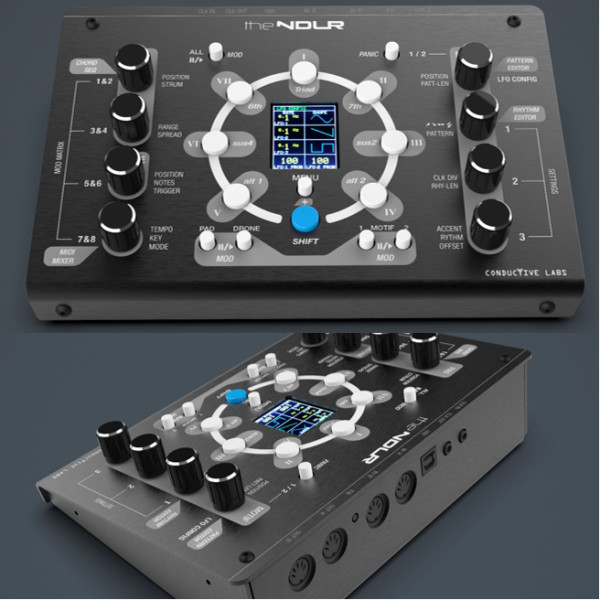
A Four Part Polyphonic MIDI Sequenced Arpeggiator with Mod Matrix!
What our supporters have to say:
“I just got my NDLR a few days ago and I love it! It has opened up a whole new way of “jamming” with my synths and I couldn’t be happier! What an amazing product. I look forward to everything you guys do in the future!!!”
“I’ve been plugged for 5 minutes and I am completely floored!! NDLR is a beautiful work of art!”
“The NDLR is a really great, inspirational box that brings the best out of your synths!”
“Love the NDLR!”
The NDLR ~ Four-track, Sequenced Arpeggiator, Chord Player and Drone ~
We’ve turned complex music theory into a killer synthesizer jamming MIDI controller. With four parts that can play up to 8 synths, you can make fantastic electronic music, such as soundscapes, electronica, ambient, electro, or techno to name a few. Whether noodling in your music space after work or jamming with friends, The NDLR can take your music to amazing places!
The Four Parts
The PAD part is a chord player. Press one of the 7 chord buttons and hear beutiful PADs on your favorite poly synth. All of the other parts change notes to match. When you press a chord button the notes stay on until you press the next chord or stop the part, so you can twist knobs on your synths or play a lead part on guitar. Change the chord octave position, range, spread, chord type, key and mode.
There are two “Motifs” which are extremely versatile sequenced arpeggiators. Select a pattern for each one and go! Independently tweak on clock division, pattern length, octave position and more. You can create your own patterns with the onboard pattern editor, and add rhythm with the onboard Rhythm editor. The motifs play the notes contained in the currently selected chord, so you don’t need to pick notes on a keyboard. The NDLR supports a 10 to 300 BPM clock so play as fast or slow as you like, or use an external clock source.
The Drone part can play a single continuous note like a traditional drone does… or choose from various retrigging options, such as having the note retrigger on a chord change, the down beat, every beat, up beat, etc. You can also choose to add a 3rd and/or 5th note for a polyphonic drone. Or have the drone play a thundering kick if you want to.
Hook It Up
Just connect up your hardware and virtual synths with MIDI cables or USB MIDI, select what plays on each MIDI channel, then press the play buttons to start playing. With two 5 pin DIN inputs, two outputs, plus 4 USB virtual MIDI ports, you can hook it up in any setting.
Use the seven chord buttons on The NDLR to play chords, the other parts notes change with the chords you play. Or expand the arp note pool by making your own motif patterns in scale or chromatic mode.
Twist the knobs to vary the chord, drone and each of the 2 arpeggiators. Change the chord type, the key, pick from numerous modes and scales (Major, Minor, Lydian, etc.). The NDLR keeps everything in-key and in-time! You can “play” The NDLR, or let it play while you twist knobs on your synths. Someone says, “play in the key of D”, just turn the Key knob until it shows the key of D. Now you are playing in key.
You can play up to eight synths at once, no extra appendages required:
- An arpeggiated bass line to one synth.
- An arpeggiated sequence to your favorite lead synth.
- Play chords to a poly synth, with real time tweakable range and position to up to four synthesizers by using our amazing “interleaved poly-chaining”.
- A drone note plays a note based on the current chord, targeting those exotic evolving synth patches. It can play a continuous note, or you can select from various trigger patterns.
- A transposed MIDI pass-through. Transposes notes from your favorite external sequencer or keyboard controller from the key of “C” into your selected key.
Once you’ve got the basics down, delve into advanced features like the 8x Modulation Matrix to automate and add motion to The NDLR controls. Connect a MIDI keyboard and Sequencer to The NDLR’s two MIDI inputs. External CC control is available for nearly every parameter. An on-board Pattern and Rhythm editor lets you create custom arps. Use the clock out port with time division to clock your sequencer, great for making chord changes at a slow BPM. The NDLR can provide MIDI clock, or slave to an external clock source to stay in sync with your other gear.
Once you hear that awesome sound you were going for, save your patches and settings for later recall. There are 8 global save slots, 20 user pattern slots and 20 user rhythm slots.
Watch the videos and check the specs below for more details.
What You Get
The Perk for backing The NDLR is: The NDLR with a USB cable, at a discount from the normal selling price. We supply the USB cable, you supply the USB power. Any quality USB phone charger will do, a PC’s USB port, or even power The NDLR for hours from a USB battery pack.
Actual production The NDLR:
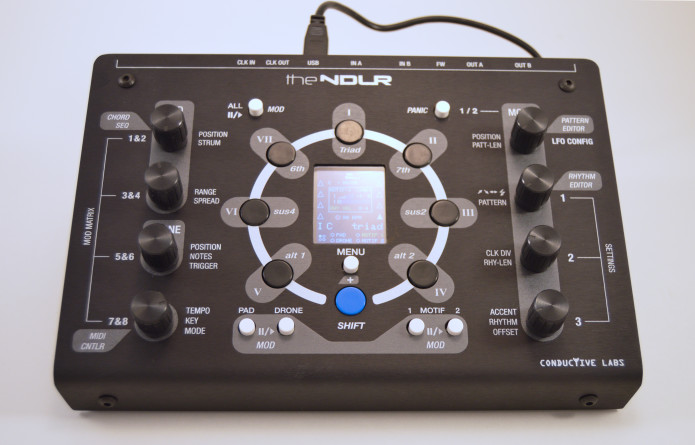
Made of anodized 5052 aluminum, it doesn’t just look bad @ss, its effect pedal tough
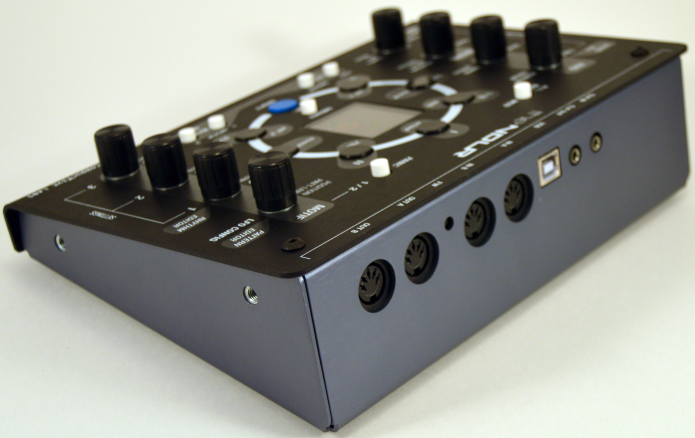
The NDLR’s in overnight “burn-in” to ensure reliability
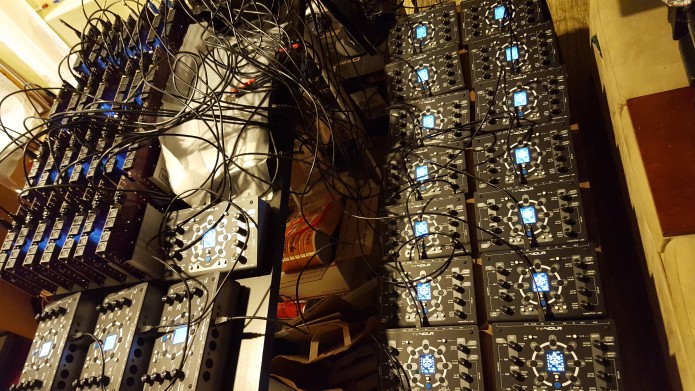
The final Production Boards look like this
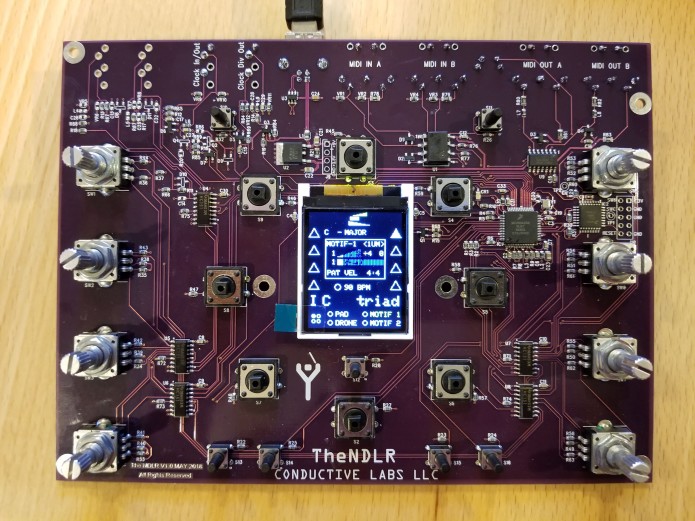
Hundreds of production circuit boards and enclosures
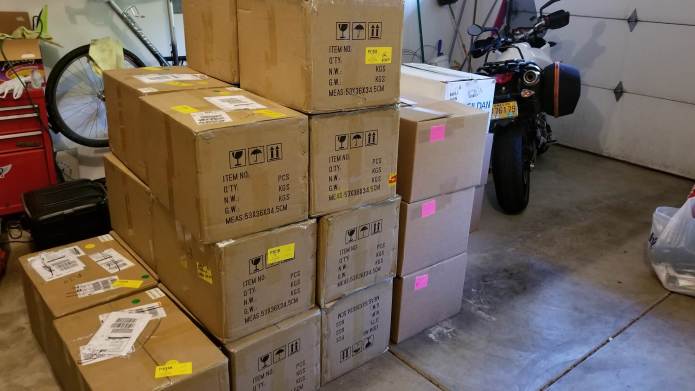
The accessory parts; USB cables, knobs and tons of little rubber feet!
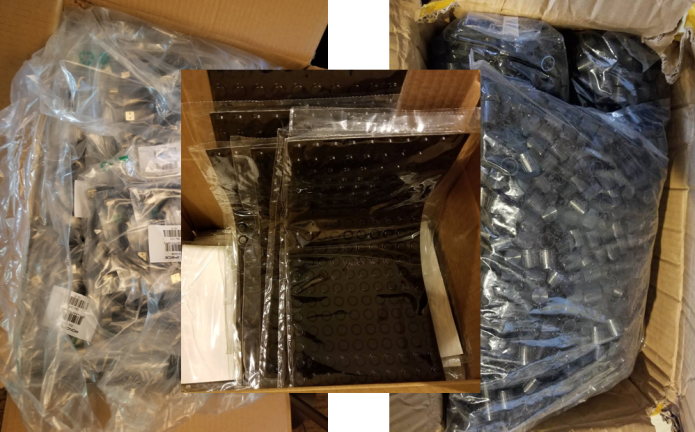
Risks & Challenges
The next batch of The NDLR are shipping. Order yours today!
The NDLR Specs… if you want to dive in, check out the manual on our website
Physical Layout:
- Dims: Size 9”W x 6.3”L x 2.8″H (22.8 x 16 x 7.1cm)
- Color LCD Screen 1.8” (128×160)
- 8 Rotary Encoders w/ switch
- 7 Chord Buttons (degree / type)
- 4 Play/Pause Buttons (PAD, Drone, Motif 1, Motif 2)
- Motif 1 or Motif 2 Select and Panic (MIDI all notes off)
- Global Play/Stop Button and Modulation pause
- Shift & Menu Buttons
- Recessed Firmware Update Button (upgrades via USB)
Physical Input/Output:
- 2x MIDI 5-Pin Inputs
- 2x MIDI 5-Pin Outputs
- 1x USB w/ 4 Virtual USB MIDI I/O ports + Power
- 1x Clock Out 1/8th inch jack
- 1x Clock In 1/8th inch jack
MIDI-in Options:
- Connect a MIDI keyboard or sequencer and The NDLR can transpose from the key of “C” to the current NDLR key & mode.
- Use a MIDI keyboard or sequencer to select chords. Choose The NDLR “Control-In” MIDI channel. The white keys map to chord degrees I-VII. Optionally black keys map to the chord type. Sonority is automatic based on key & mode.
- Most features of The NDLR can be controlled by inbound CC messages.
- All notes and CCs pass thru except for The NDLR control channel.
- With 2 MIDI 5 pin and 4 USB MIDI in and outs, The NDLR is a MIDI merger and a MIDI splitter. See the manual for details.
MIDI-out Options:
- Selectable Drone MIDI-out channel (Off, Pad, 1-16). Pad choice means same as Pad channel.
- Selectable Pad MIDI-out channel (1-16). When enabled, Poly-chains play on the next successive MIDI-out channel(s). Example: Pad MIDI-out ch = 4. Polychain = 1 – all pad notes on ch 4. Polychain = 2 – every two notes plays on channels 4/5. Polychain = 4 – every 4 notes plays on channels 4/5/6/7. If you are playing 6 notes with Polychain = 2, note1->ch4, note2->ch5, note3->ch4, note4->ch5, note5->ch4, etc.
- Selectable Motif 1 MIDI-out port and channel.
- Selectable Motif 2 MIDI-out port and channel.
- MIDI out ports are USB 1 thru 4, and 5 pin din MIDI A and MIDI B.
Features:
All Parts’ notes are derived from the chosen chord degree, chord type, key, & mode. See the manual on our web site for excruciating details.
Pad – Note Position and Range. Moving the position and changing the range will turn notes on and off, great for awesome soundscapes. Up to 49 notes of poly!
Drone – Note Position, Number of notes, and Trigger. Plays 1 to 3 notes continuously or tiggers on beats. Changes with chords or stays on the root note. Good for long evolving synth patches or punchy bass.
Motif 1 and 2 – Note Position, Length and Variation for Patterns and Rhythms. Use built-in patterns and rhythms or create your own. These sequenced arpeggiators are great for creating lead and bass lines.
Tempo, Key and Mode settings -provide maximum flexibility for solo noodling or jamming with friends.
Menu System – No menu diving, our flat menus make it easy to navigate the 8 menus and the Pattern and Rhythm editors.
Save and Load User Settings:
- Save and load up to 8 global system settings including most performance parameters. Global settings can be changed on the fly.
- In addition to the built in 20 patterns and 20 rhythms; Save 20 user patterns in the Pattern editor. Save 20 user rhythms in the Rhythm editor
- Modulation – an 8 slot mod matrix with Source, Destination, and Amount.
- 3 LFO sources – Rate: 0.4 – 40 seconds free running, 1 to 48 beats synced.
- Wave Shape (Sine, Tri, Sqr, Pulse, S&H, and Patterns). Probability for LFOs 1 and 2.
- Additional mod sources include; pitch bend, velocity, CCs and aftertouch.
- Modulation destinations include most all The NDLR parameters.
- Modulate parameters on your synths with any MIDI CC (1-127).
- MIDI CC control – Most all of The NDLR parameters are CC addressable. See the MIDI CC Implementation table in the User Manual on the Downloads page.
Clock (sync):
- Internal MIDI clock out (10-300 BPM)
- Internal CV clock out (0-5V), 1 PPQ, 2 PPQ for Korg Volcas, 24 PPQ, with Clock divide.
- External CV Clock In (5V max, currently 24 PPQ only)
- External clock-in on MIDI-in 5 pin A, B or USB (1-4).
Credits
Steve and Darryl are veterans of the hi-tech industry, with over 50 years of combined experience in product development. We’ve worked on projects ranging from audio/video codecs, residential gateways and routers, cloud security services, to wireless display technology. Having taken early retirement, we are now following our passion and working full time on building a business around our synthesizer habit. Steve is an EE that studied music theory which is being put to good use here. However, a project like this takes a lot of work and expertise and we’ve been lucky to have a network of “Really Smart Friends” who are assisting us:
- Paul has been a lead electrical engineer for a musical instrument company for over 20 years. He made an analog synth while in high school and has a complete recording studio in his house! He is beta testing, advising on the electrical design and helping with the PCB layout. The NDLR would likely be the simplest thing he’s ever worked on.
- Ben is a veteran mechanical engineer, and is helping with mechanical drawings and advising on best practices for manufacturing. His best advise? Keep it simple, so we did!
- Kelly the G-code man made the prototype plexiglass faceplates on his CNC router and the production LCD screen protectors with the addition of a Glowforge laser cutter.
- Andy for his vector file tips and clean-up, and vinyl printing and cutting for the prototype faceplates.
- Craig Anthony Perkins (aka Genshi), a synth performer and composer, former video game QA lead, and Product Manager at a large music gear company, is beta testing and has made some cool performance videos of The NDLR. Check out his YouTube channel.
- Nick Oakley, award winning designer, is contributing the artwork for The NDLR. And wow, it looks fantastic!
And a big thanks to our KS and Indiegogo backers who made this all possible!

